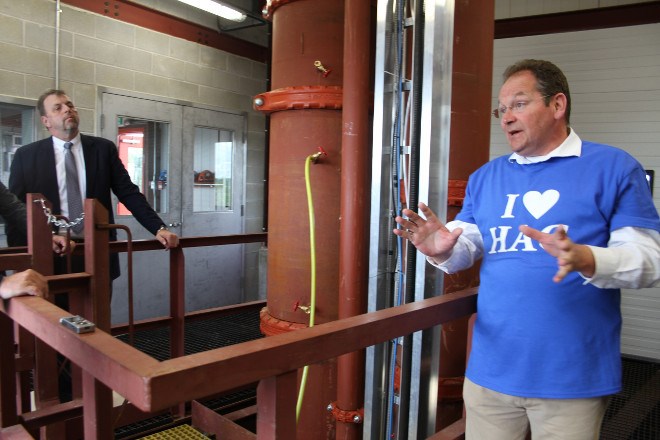A new attraction on display at Dynamic Earth in Sudbury is bringing a century-old invention to the modern age with the aim reducing the costs of deep mining.
The Hydraulic Air Compressor (HAC) demonstrator was unveiled at the tourist attraction with much fanfare on June 21.
The 100-foot-tall industrial scale system for testing and demonstrating air compression was installed in its own headframe in a former elevator shaft that used to be a part of Big Nickel Mine.
“This project is going to do so much more than develop a new air circulation system, it's going to rewrite the textbook on thermodynamics,” said project lead Dean Millar in an interview.
“This will make deep mining here in Sudbury, and ultimately the rest of the world safer, more cost efficient and greener.”
The HAC Demonstrator project is a joint undertaking of a Sudbury research consortium involving the Ultra-Deep Mining Network (UDMN), MIRARCO Mining Innovation, Laurentian University, Electrale Innovation, Reasbeck Construction, Independent Electricity System Operator, Northern Ontario Heritage Fund and Dynamic Earth.
Millar explained the technology is new but the concept is more than a century old.
This project is based on the Ragged Chutes hydraulic air compressor plant designed by Canadian engineer Charles Havelock Taylor in 1910 for the Cobalt mining camp in northeastern Ontario.
The Ragged Chutes plant included a dam on the Montreal River and a 9.5-foot diameter shaft blasted to a depth of 107 metres.
Intake pipes at the top of the shaft introduced air into the water as it plunged down the shaft. The force of the water compressed the air, which was then piped to a dozen mines to provide pneumatic power.
Ragged Chutes required no fuel, cost almost nothing to operate and ran continuously for 70 years with two brief interludes for maintenance.
Unlike the Ragged Chutes plant, the demonstrator at Dynamic Earth will use a pump to re-circulate the water in the shaft.
A strange thing happens to the air when it is compressed in the water, it cools, which Millar says is counter to how gasses behave when they are compressed as the water keeps it cool.
Once the water reaches the bottom of the shaft the gasses would release, be mixed with the warmer air at the bottom in a circulation system and be pumped into the mine.
At one point there were about 13 of these systems around the world, and they worked for decades non-stop.
However, Millar said they were not popular with miners because a lot of the oxygen would stay dissolved in the water, causing the candles they used in the mines to burn dimmer.
As well, at the time, electric power was much easier to sell to the mines.
“It was a matter of marketing,” he said. “The electrical companies could move power further away from the source and have a marketable product. You can't move compresses air fast enough to where it will be consumed.”
With the cost of power being a major issue for mines he said a system like this could cut costs as it is self-contained and uses much less energy.
The team is addressing the dissolved oxygen problem as well and Millar said he may have come up with a solution while having lunch with a friend a year ago.
He watched as his friend poured salt into his beer, causing it to fizz rapidly.
“I saw that and realized salts cause gasses to be released from the liquid, so we are going to test different salts in the water to see which ones release oxygen, while trapping others,” he said.
“This could even help with carbon capture in mines and oil fields, we have so many experiments we are planning.”
The large HAC is one of two, Millar explained. There is a smaller “baby HAC” at Cambrian College, which they run preliminary tests on. Eventually, the larger HAC will be used for experiments in real-life situations.
While it is an attraction for the public to view, it's still an ongoing project.
Experiments that will help benefit mining and education will be running at the facility for at least five years. So far, the results are encouraging to the team and the partners.
Bora Ugurgel, managing director for Ultra-Deep Mining Network said this kind of system will cut energy costs for mines and make working far underground more productive.
“As mines go deeper, they get hotter. Having alternative technologies to cool them instead of mechanical cooling is of interest to us,” he said.
“For ultra-deep mining, reducing the energy costs and improving the ventilation will make deep mining more financially feasible in the future.”
He added the technology was proven a century ago, but the key component was a river, something not all mines have at their disposal.
This system is proving it can bring the technology to a mine without a river and provide benefits of cooling air, as well as other benefits like capturing greenhouse gasses. Having a closed-loop system without a river is the innovation.
The event was also a family event.
Brad Taylor, the grandson of Charles, was at the unveiling with his wife Jill.
He said it was an emotional experience to see something his ancestor created decades ago being reintroduced to revolutionize the mining industry.
“He died about six months before I was born, but I've heard so many stories of his genius and to see it here again, it's overwhelming,” he said.
“He had so many patents. He invented the rollerblade. He loved to skate so came up with a six-inch wheel to rollerblade in the summer so he could keep skating.”




